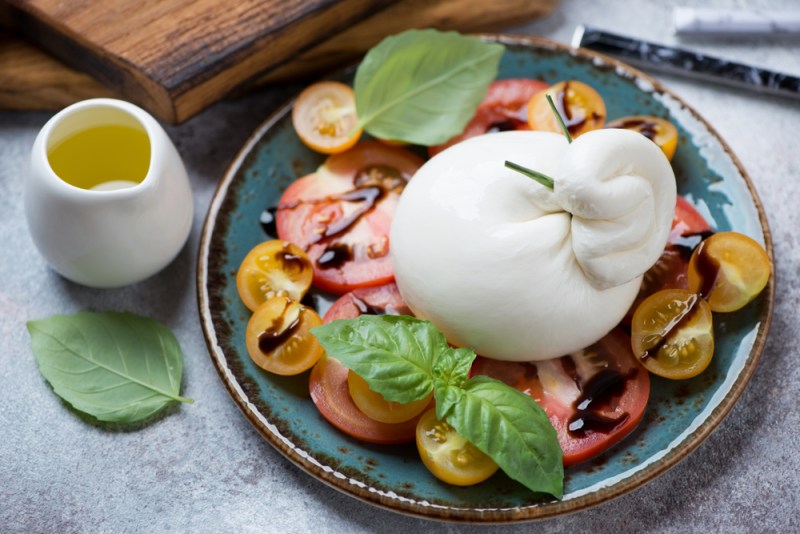Burrata is an extremely creamy, semi-soft, white Italian cheese. This formaggio is so decadent, it gets its name from the Italian word for butter. Basically, it’s mozzarella and heavy cream encased in more mozzarella. If meta-mozzarella sounds like something you can get down with, scroll forth to find out more about this dairy delight’s origins, production, uses, and more.
Taste & Texture

Since this cheese is freshly made from milk, it tastes and smells a lot like…milk. Its soft shell gives a balanced contrast to the sumptuously creamy interior. The mild, smooth, and fresh sheath of mozzarella gives way to a rich and buttery inside composed of spreadable strings soaked in cream with a slightly sour finish. Chewy and rubbery mozzarella “skin” is a sign that the cheese has lost its freshness.
History

Burrata originated in the Apulia region of southern Italy, which forms the country’s boot heel. Originally, it was spun by artisans using scraps that were leftover from producing mozzarella di bufala, or mozzarella that was made with water buffalo milk. Fun fact: North America is home to bison, not buffalo as the cowboy song suggests. Buffalo milk is richer and higher in butterfat than cow milk the burrata that you find here in the states is usually made with pasteurized cow’s milk. While burrata has been a popular part of Mediterranean cuisine since the ‘50s, it didn’t make its way across the pond until the ’90s. Still, burrata didn’t really become trendy until the past decade or so. These days, there’s a whole restaurant in LA dedicated to its decadence.
How It’s Made

Rennet causes warmed milk to curdle, forming little clumps, or curds. The proteins that don’t clump up is what’s called whey. I am 36 years old and just found out that Little Miss Muffet’s curds and whey is basically cottage cheese. Curds are then molded and pressed to create a wheel or block of cheese. Instead of molding and pressing the mozzarella, burrata is made by stretching or pulling the curd, which is referred to as pasta filata. It is then formed into a “pouch” and packed with soft stringy bits of curd, called ritagli “rags” and stracciatella “ribbons”. Then, it’s topped off with fresh heavy cream before being knotted closed at the top. Traditionally the cheese was wrapped in the leaves of an asphodel plant, but here it is sold in plastic containers.
Where to Buy Burrata

BelGioioso has hopped on the burrata making train, so you should be able to find it at the grocery. (They also make a black truffle version.) It can also be found in Italian markets as well as artisanal cheese shops. Otherwise, you can always make your own burrata at home in an Instant Pot!
How to Use Burrata

Fresh cheese is not meant to be aged, like cheeses that have a rind. As cheese.com puts it, burrata boasts “clearer flavors in its youth.” Therefore, you should try to eat it all within a couple days of purchasing. Let it sit out for at least half an hour and serve at room temperature. The thick cream will pour out once you slice into it, so if you’ve got a cheese board going on, you might want to serve it separately. Its soft, liquid-like interior can make it tough to slice, so use a serrated knife for the best results.
Recipes

Burrata is best friends with crusty bread, but you can also sub it out for mozz in a Caprese situation, similar to this recipe for Tomatoes & Burrata. Love & Lemons pair it with peaches and pistachios in their simple summer recipe for Burrata with Heirloom Tomatoes. Buratta plays nicely with peas, but it also plays off of the classic combo of strawberries and balsamic, like in this Burrata + Balsamic Glazed Strawberry Grilled Cheese or Food and Wine’s play on avocado toast. Use it to add contrast to ripe berries, honeydew melon, and grilled figs; pair it with prosciutto; put it on top of a salad; or serve with roasted or grilled veggies. If you can get your hands on some truffles, try it with Eataly’s black truffle vinaigrette! It is not recommended to heat burrata since that compromises the flavor profile. You can put it on pasta, but for pizza, you’re better off using it’s basic and more affordable cousin, mozz.
Storage

It’s best to consume this highly perishable cheese tout suite, but if you simply can’t eat it all in one sitting, keep it in an airtight container in the fridge for a day or two. When the freshness says “ciao,” it smells and tastes sour like milk that has seen better days because that’s basically what it is.
Substitutions

There is no substitute for buratta’s lush, creamy texture, but mozzarella will do in a pinch.
